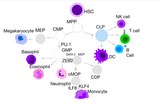Dendritic cell
Dendritic cells (DCs) are white blood cells forming part of the mammalian immune system. They process antigen material from pathogens and put it on their surface. There it touches other cells of the immune system. So, dendritic cells are antigen-presenting cells. They act as messengers between the innate and adaptive immune systems.
Dendritic cells are present in tissues in contact with the external environment. These tissues are the skin, and the inner lining of the nose, lungs, stomach and intestines. They can also be found in an immature and mature state in the blood.
Young dentritics
Dedritic cells develop from monocytes, white blood cells which circulate in the body. Depending on the signal, monocytes turn into either dendritic cells or macrophages. The monocytes are formed from stem cells in the bone marrow.
Immature dendritic cells constantly sample their surrounds for pathogens such as viruses and bacteria. This is done through pattern recognition receptors (PRRs) such as the toll-like receptors (TLRs).
They eat pathogens and break down their proteins into small pieces and put these fragments on their cell surface using MHC molecules. Once activated, these cells move to the lymph nodes and become mature.[1] They switch on cell-surface receptors which activate T cells and B cells to start and shape the adaptive immune response.
History
Dendritic cells were first described by Paul Langerhans (Langerhans cells) in the late nineteenth century. It wasn't until 1973, however, that Ralph Steinman and Zanvil Cohn gave them the name 'dendritic cells'.[2] For discovering the central role of dendritic cells in the adaptive immune response,[3] Steinman was awarded the Albert Lasker Award in 2007,[4] and the Nobel Prize in Physiology or Medicine in 2011.[5]
Dendritic Cell Media
A well-resolved dendritic cell drags a conidium through a distance of up to 9 μm. The conidium, however, is not phagocytosed by the cell. The observation was made over 3 h with one frame every 30 s.
A single dendritic cell can be seen here efficiently taking up at least four conidia in its vicinity.
References
- ↑ At a particular stage, these cells grow branches called dendrites. The name comes from the Greek word δένδρον, or déndron that means "tree". Immature dendritic cells are also called veiled cells, as they have large cytoplasmic 'veils', not dendrites.
- ↑ Steinman R.M. & Cohn Z.A. (1973). "Identification of a novel cell type in peripheral lymphoid organs of mice. I. Morphology, quantitation, tissue distribution". J. Exp. Med. 137 (5): 1142–62. doi:10.1084/jem.137.5.1142. PMC 2139237. PMID 4573839.
- ↑ Banchereau J. & Steinman R.M. (1998). "Dendritic cells and the control of immunity". Nature. 392 (6673): 245–52. doi:10.1038/32588. PMID 9521319. S2CID 4388748.
- ↑ "The Lasker Foundation - 2007 Awards". Retrieved 2010-11-27.
- ↑ "Nobel Prize in Physiology or Medicine for 2011"".

